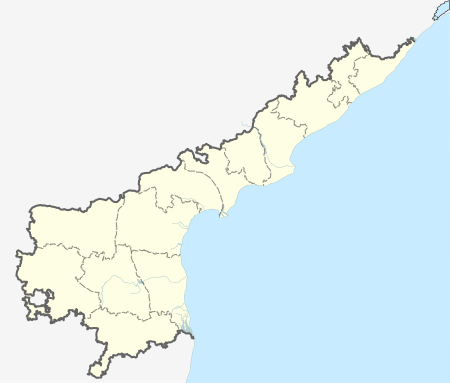Badangi mandal
| Badangi mandal బాడంగి మండలం | |
|---|---|
| Mandal | |
 Badangi mandal Location in Andhra Pradesh, India | |
| Coordinates: 18°29′44″N 83°22′06″E / 18.4956°N 83.3682°ECoordinates: 18°29′44″N 83°22′06″E / 18.4956°N 83.3682°E | |
| Country | India |
| State | Andhra Pradesh |
| District | Vizianagaram |
| Headquarters | Badangi |
| Population (2011) | |
| • Total | 48,219 |
| Languages | |
| • Official | Telugu |
| Time zone | IST (UTC+5:30) |
Badangi mandal is one of the 34 mandals in Vizianagaram district of Andhra Pradesh, India. Badangi is the headquarters of the mandal. The mandal is bounded by Bobbili, Therlam, Merakamudidam and Ramabhadrapuram mandals.[1]
Demographics
As of 2011 census, the mandal had a population of 48,219. The total population constitute, 24,357 males and 23,862 females.[2] The entire population is rural in nature.
Government and politics
Badangi mandal is one of the four mandals in Bobbili (Assembly constituency), which in turn is a part of Vizianagaram (Lok Sabha constituency), one of the 25 Lok Sabha constituencies representing Andhra Pradesh.[3] The present MLA is Venkata Sujay Krishna Ranga Rao Ravu, who won the Andhra Pradesh Legislative Assembly election, 2014 representing Yuvajana Sramika Rythu Congress Party.[4][5]
Rural villages
As of 2011 2011 census of India, the mandal has 27 settlements, consisting of 27 villages. Koduru is the most populated and D. Venkayyapeta is the least populated village in the mandal.[6]
The settlements in the mandal are listed below:
- Akulakatta
- Anavaram
- Badangi
- Bheemavaram
- D.Venkayyapeta
- Donkinivalasa
- Gajarayunivalasa
- Golladi
- Gopalakrishnarangarayapuram
- Gudepuvalasa
- Kamannavalasa
- Koduru
- Kotipalle
- Lakshmipuram
- Mallampeta
- Mugada
- P.Venkampeta
- Paltheru
- Pedapalle
- Pinapenki
- Pindrangivalasa
- Pudivalasa
- Ramachandra Puram
- Rejeru
- Tentuvalasa
- Vadada
- Veerasagaram
References
- ↑ "Mandals in Vizianagaram district". aponline.gov.in. Retrieved 16 September 2014.
- ↑ "Sub-district details". Census of India. Government of India. Retrieved 9 February 2016.
- ↑ "DELIMITATION OF PARLIAMENTARY AND ASSEMBLY CONSTITUENCIES ORDER, 2008" (pdf). Election Commission of India. p. 22. Retrieved 20 October 2014.
- ↑ "MLA". AP State Portal. Retrieved 20 October 2014.
- ↑ "Assembly 2014 Election Results". Elections.in. Retrieved 20 October 2014.
- ↑ "Sub-District Details of Vizianagaram District". The Registrar General & Census Commissioner, India. Retrieved 12 February 2016.
 |
Bobbili mandal | Bobbili mandal | Therlam mandal |  |
| Ramabhadrapuram mandal | |
Therlam mandal | ||
| ||||
| | ||||
| Ramabhadrapuram mandal | Ramabhadrapuram mandal | Merakamudidam mandal |